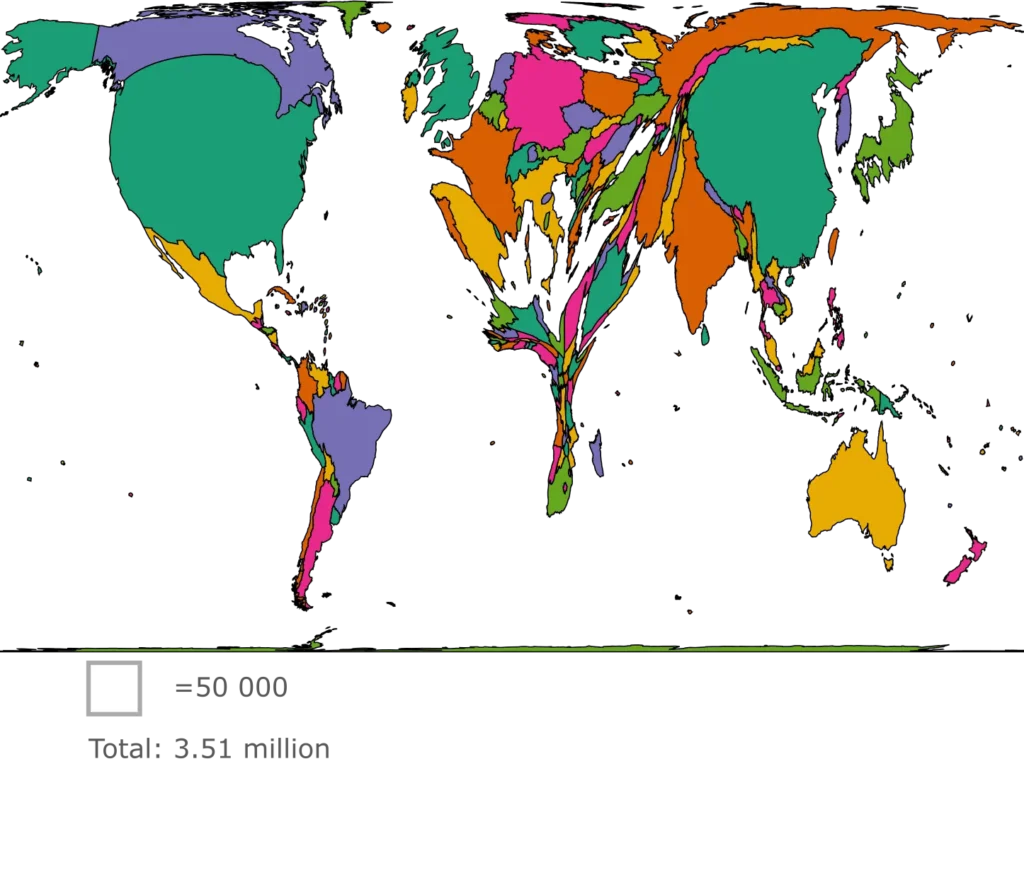Artificial intelligence has the potential to transform economies and societies. However, analysis using Dimensions by Senior Data Scientist Hélène Draux at Digital Science showed that AI research and development remain highly uneven, with publications and grants heavily concentrated in just a few advanced countries.
Using the Dimensions’ Fields of Research classification system, Dr Draux interrogated a range of data to explore and visualize the global landscape of artificial intelligence (AI) research, highlighting the growing divide in the AI capabilities of different countries. Outcomes included:
- A cartogram visualizing artificial intelligence (AI) research from 2014 to 2023, with the contours of each landmass showing the number of peer-reviewed papers produced across core AI subfields. The cartogram showed the US and China leading the way with a 30% and 18% share, respectively. Meanwhile, Africa, South America and most Asian nations contributed less than 5%, indicating largely untapped AI potential across the Global South. “Addressing these deep disparities should be a top priority for transitioning towards more equitable and inclusive AI development globally,” Dr Draux noted.
- An analysis of trends in the top 10 countries that published AI research, based on Dimensions’ data for 2012 to 2023. This showed emerging economies like China, India and others gaining ground in AI research, reflected by their rapidly growing publication output over the past decade. Though traditional leaders in North America and Europe continue to produce high volumes, developing countries are claiming more seats at the table and diffusing expertise globally.
- Insight into the distribution of AI publications between public and private research institutions from 2012 to 2023. Dr Draux used the Global Research Identifier Database (GRID – a database of educational and research organizations), which showed that universities
Corporate research can lack transparency regarding data and methods and the priorities for corporate AI research may be driven more by commercial opportunities than scientific or social values. Dr Draux writes: “This means that important basic research with less immediate real-world application is at risk of becoming underfunded.” - Geographic funding trends. Using Dimensions to collate publicly available research funding data, Draux found that the dominance of China and the US in AI research output correlates strongly to funding trends. Between 2012 and 2020, the United States saw AI funding grants rise from 10,210 to 11,467. Yet Japan and China marked larger overall gains, with Japan increasing its funding grants from 3,775 in 2014 to 6,465 in 2020 and China increasing from 4,267 to 7,345. Growing global recognition of AI’s revolutionary potential across almost all major industries has driven heavier funding year after year. Dr Draux notes that if the world maintains this pace, analysts forecast total AI research funding could double again before 2030.

Analysis of the data shows stark global divides in AI research and development. “The data highlights how a handful of advanced Western countries and China continue to outpace most other nations in key AI research metrics vastly. Though divides show signs of blurring, deep funding, and infrastructure disparities persist globally.”
Research for this article was made possible by leveraging several key features of Dimensions.
- Fields of Research (FoRs): This above-mentioned feature refers to the selection of the corpus to study was simplified by Dimensions’ pre-defined classifications (see, for instance, a recently published description of the result from different classifications). Given the complexity and size of the field of AI, there are six relevant FoRs: basic (foundational theories of AI and core principles of ML) and applied (Computational Biology, Mathematics, and Psychology).
- Google Big Query (GBQ): Access to Dimensions’ data is available through a web app, an API, and in Google Big Query (GBQ). Although the web app gives quick insights without technical skills, the API and GBQ provide an opportunity to write quick and reproducible analyses.
- Global Research Identifier Database (GRID): The creation and maintenance of the Global Research Identifier Database (GRID) by Dimensions is a cornerstone for uniquely identifying research institutions. Not only does the system disambiguate research affiliations but it also classifies institutions following a typology depending on the institutions’ functions: Archive, Company, Education, Facility, Government, Healthcare, Nonprofit, and Other.
- Geography ready: One common challenge in data analysis is the unification of country names when merging geographic data. GRID, available in GBQ, uses the alpha-2 country coding scheme, facilitating seamless integration with external datasets and tools like the cartogram application used in this analysis https://go-cart.io/cartogram and standard plotting analysts libraries.
- Funding identifiers: Finally, Dimensions extracts funding information from three sources: publications’ acknowledgments sections, directly from funders, and through databases like PubMed and CrossRef. Each funding source is linked to a unique GRID identifier, providing detailed information about the funder’s location and type.
Read the complete article Research on Artificial Intelligence – the global divides on the Digital Science TL;DR website
To learn more about how you can use Dimensions, contact the Dimensions team.
